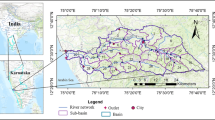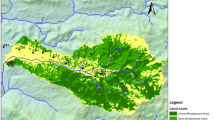Abstract
Land-use change is one of the major factors that alter local and regional hydrology. For areas experiencing fast expansion of urban and agriculture areas, land-use changes often adversely affect stream flow and water resources at the local and watershed scale. The Sekong, Sesan, and Srepok (3S) Sub-basins are a part of the Lower Mekong River Basin and include land in Cambodia, Lao People’s Democratic Republic (Laos), and Viet Nam. The region is experiencing a dynamic land-use transition because of rapid changes in its economy, society, and environment. Major land-use changes include deforestation of native rain forest, expansion of agricultural and urban areas, and expansion of commercial plantation such as rubber trees. These land-use alterations have affected local and regional hydrologic processes, resulting in stream flow shortages during the dry season and flash flooding due to deforestation. In this research, deforestation in the 3S Sub-basins over the period 1993–1997 was analyzed using multi-logistic regression. The regression analysis indicated that density of agricultural cells within a 5-km radius from each forest cell and slope strongly affected the deforestation process. A land-use forecast model to simulate deforestation and urbanization sites was developed in GIS based on local land-use change trends. The model was applied to 2003 land use to forecast 2033 land use and future water demand, which was further compared with present stream flow measurements during the dry season at various places in the region. The entire approach from the land-use forecast to its impact assessment on stream flow could help local stakeholders understand watershed-wide future water resources risks and develop future water resources plans. With the 3S Sub-basins being used as a case study area, this article presents a land-use forecast tool; simulated 2033 land-use and water demand; and the estimation of the impact of the forecasted future water demand on the local stream flow.













Similar content being viewed by others
References
ADB (Asian Development Bank) (2009) Sesan, Sre Pok and Sekong River Basins Development Study in the Kingdom of Cambodia, Lao People’s Democratic Republic and Socialist Republic of Viet Nam. TA6367 (REG), Manila
Basins (2011) 3Ss Basins-Sekong Se San and Se Pol Rivers. Large scale infrastructure—irrigation. http://www.3sbasin.org/reta/index.php?option=com_content&view=category&layout=blog&id=140&Itemid=177&lang=en
Braimoh AK, Osaki M (2010) Land-use change and environmental sustainability. Sustain Sci 5:5–7
CarlBro Intelligent Solutions (2005) Srepok River Basin profile, report no. T-203-1
Cochrane TA, Arias ME, Teasley RL, Killeen TJ (2010) Simulated changes in water flows of the Mekong River from potential dam development and operations on the Se San and Sre Pok tributaries. Montreal: IWA World Water Congress and Exhibition (IWA 2010), 19–24 Sep 2010
Croke B (2005) Land-use impacts on hydrologic response in the Mae Chaem attachment, Northern Thailand. In: Kachitvichyanukul V, Purintrapiban U, Utayopas P (eds) Proceedings of the 2005 international conference on simulation and modeling
Foley JA et al (2005) Global consequences of land-use. Science 309:570–574
ICEM (2003a) Cambodia national report on protected areas and development: review of protected areas and development in the Lower Mekong River region. Queensland: International center for Environmental Management (ICEM)
ICEM (2003b) Lao People’s Democratic Republic national report on protected areas and development: review of protected areas and development in the Lower Mekong River region. Queensland: International Center for Environmental Management (ICEM)
ICEM (2003c) Vietnam national report on protected areas and development: review of protected areas and development in the Lower Mekong River region. Queensland: International center for Environmental Management (ICEM)
Katsuyama M, Shibata H, Yoshioka T, Yoshida T, Ogawa A, Ohte N (2009) Applications of a hydro-biogeochemical model and long-term simulations of the effects of logging in forested watersheds. Sustain Sci 4:179–188
Kawasaki A, Takamatsu M, He J, Rogers P, Herath S (2010) An integrated approach to evaluate potential impact of precipitation and land-use change on streamflow in Srepok River Basin. Theory Appl GIS 18(2):9–20
Kim HS, Croke BFW, Jakeman AJ, Chiew FHS, Mueller N (2007) Towards separation of climate and land use effects on hydrology: data analysis of the Googong and Cotter Catchments. MODSIM 2007 International Congress on modeling and simulation, pp 74–80
Kingston DG, Thompson JR, Kite G (2011) Uncertainty in climate change projections of discharge for the Mekong River Basin
MRC (Mekong River Commission) (2009) Basin Development Plan, phase 2 (BDP2): hydropower sector review for the joint basin planning process. Vientiane. Draft report
MRC (Mekong River Commission) (2010) Report on flow conditions in 2010 dry seasons
Muller D, Munroe DK (2004) Tradeoffs between rural development policies and forest protection: spatially-explicit modeling in the Central Highlands of Viet Nam. Selected paper prepared for presentation at the American Agricultural Economics Association annual meeting, Denver, Colorado, July 1–4
Qiu J (2009) Where the rubber meets the garden. Nature 457(15):246–247
R Development Core Team (2008) R: a language and environment for statistical computing. R Foundation for Statistical Computing, Vienna. ISBN: 3-900051-07-0. http://www.R-project.org
Richter BD, Baumgartner JV, Powell J, Braun DP (1996) A method for assessing hydrologic alteration within ecosystems. Conserv Biol 10:1163–1174
Rogers P (2012) Water-energy NeXUS: sustainable urbanization in the Greater Mekong Subregion, GMS 2020
Schilling KE, Jha MK, Zhang YK, Gassman PW, Wolter CF (2008) Impact of land-use and land cover change on the water balance of a large agricultural watershed: historical effects and future directions. Water Resour Res 44:12
Schlesinger WH, Reckhow KH, Bernhardt ES (2006) Global change: the nitrogen cycle and rivers. Water Resour Res 42:2
SCW (Save Cambodia’s Wildlife) (2006) The atlas of Cambodia: national poverty and environment maps, Phnom Penh
Stonestrom DA, Scanlon BR, Zhang L (2009) Introduction to special section on impacts of land-use change on water resources. Water Resour Res 45:3
Tanji H (2005) Water use and management system in the Mekong River. In: Proceedings of the second symposium on R&D of hydrological modeling and water resources system (In Japanese)
Turner BL, Lambin EF, Reenberg A (2007) The emergence of land change science for global environmental change and sustainability. Proc Natl Acad Sci 104:20666–20671
Ty T V (2011) Development of a comprehensive approach for water resources assessment at various spatio-temporal scales. Dissertation, University of Yamanashi, Japan
Verburg PH, de Koning GHJ, Kok K, Veldkamp A, Bouma J (1999) A spatial explicit allocation procedure for modelling the pattern of land use change based upon actual land use. Ecol Model 116:45–61
World Bank (2006) Mekong Water Resources Assistance Strategy (MWRAS): options for integrated development and management in the Se Kong-Se San-Sre Pok Catchments of the Mekong in Cambodia, Lao PDR and Viet Nam: Main report. Washington, DC
Wu W, Shibasaki R, Yang P, Tang H, Sugimoto K et al (2010) Modeling changes in paddy rice sown areas in Asia. Sustain Sci 5:29–38
Xiao X, Boles S, Frolking S, Li C, Babu JY, Salas W, Moore B, Salas W, Moore BIII (2006) Mapping paddy rice agriculture in South and Southeast Asia using multi-temporal MODIS images. Remote Sens Environ 100:95–113
Zheng HX, Zhang L, Zhu RR, Liu CM, Sato Y, Fukushima Y (2009) Responses of streamflow to climate and land surface change in the headwaters of the Yellow River Basin. Water Resour Res 45:9
Ziegler AD, Fox JM, Xu J (2009) The rubber juggernaut. Science 324:1024–1025
Acknowledgments
This study was supported by Grant for Environmental Research Projects, The Sumitomo Foundation, Japan, and the Asian Center faculty grant, Harvard University Asia Center, USA. The GIS and hydrological data set was provided by the Mekong River Commission. Mr. Pham Tan Ha, Senior Water Resources expert, Grontmij VietNam, and Dr. Ty Tran Van, lecturer, College of Technology, Can Tho University, Viet Nam, provided a great deal of valuable advice. The authors would hereby like to express our gratitude for all this support for this research.
Author information
Authors and Affiliations
Corresponding author
Additional information
Handled by Osamu Saito, UNU-Institute for Sustainability and Peace (ISP), Japan.
Rights and permissions
About this article
Cite this article
Takamatsu, M., Kawasaki, A., Rogers, P.P. et al. Development of a land-use forecast tool for future water resources assessment: case study for the Mekong River 3S Sub-basins. Sustain Sci 9, 157–172 (2014). https://doi.org/10.1007/s11625-013-0225-5
Received:
Accepted:
Published:
Issue Date:
DOI: https://doi.org/10.1007/s11625-013-0225-5




